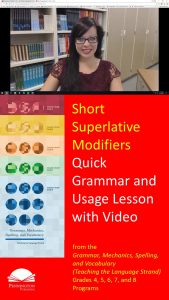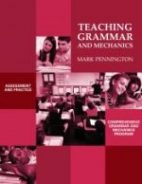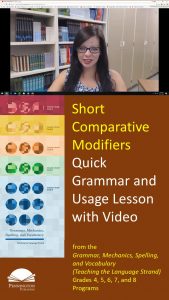
Pennington Publishing GRAMMAR PROGRAMS
Adjectives come in many forms in English. Knowing the definition of this basic part of speech only gets us so far. We do need to know what we are talking about when we refer to adjectives. Some common language of instruction only makes sense. Even the die-hard writing process folk, never fans of direct grammar instruction, have always agreed that teaching the definitions of the parts of speech is an essential. Ask English-language arts teachers what they wish their students knew about grammar. Parts of speech will come to their minds first.
But why do teachers have to re-teach adjectives every year? Is it the past teacher’s fault? Or is it simply the way we learn grammar? Following is an instructional approach guaranteed to interrupt this forgetting cycle. At the end of this article, I will share an instructional scope and sequence for adjectives with clear definitions and examples.
1. DIE AR 
(Yes, a depressing mnemonic. Perhaps an unspoken wish re: the Accelerated Reader® program?)
DEFINE Help students memorize the definitions of the key adjectival components. Rote memory is fundamental to higher order thinking. Use memory tricks, repetition, and even songs. Check out the Parts of Speech Rap. Test and re-test to ensure mastery.
IDENTIFY Help students identify adjectival components in practice examples and real text. Using quality, un-canned and authentic mentor text, such as famous literary quotations and short passages/poetry kills two birds with one stone: identification practice and sentence modeling.
EDIT Help students practice error analysis for each adjectival component by editing text that contains correct and incorrect usage. Finding out what is wrong does help clarify what is right. But don’t limit your instruction, as in Daily Oral Language, to this step. Students need the mentor texts and writing practice to master their noun components. Grammar taught in the context of reading and writing translates into long-term memory and application.
APPLY Help students their knowledge of adjectives correctly in targeted practice sentences. Sentence frames are one solid instructional method to practice application. For example, for adjectives…
It takes a lot of (idea) ________________ for a (person) ________________ to drive a (thing) ________________ to their (place) ________________.
Possible response: It takes a lot of SELF-CONTROL for a TEENAGER to drive a SPORTS CAR to their (place) to their HIGH SCHOOL.
REVISE Help students understand the importance and relevance of learning adjectives by revising their own authentic writing. Stress using what they have learned about adjectival components to improve coherence, sentence variety, author voice, word choice, clarity, and style. Make sure to share brilliant revisions that reflect these improvements as your own mentor texts. Post them on your walls and refer to them often to reinforce definition, identification, and writing style.
2. Assessments
Diagnostic assessments of key grammatical features, such as adjectives, serves two purposes: First, the results inform what to teach and how much time to allocate to direct instruction. It may be that one class tends to have mastery re: articles but weaknesses in modifiers. A different class may have a different set of strengths and weaknesses. Why so? One of the mysteries of life. Second, diagnostic assessments provide an individual baseline upon which to build learning. Sharing this data with students is vital. Students need to know what they know and what they don’t know to motivate their learning and see the personal relevance of the instructional task. Check out my favorite whole class diagnostic grammar assessment under Free ELA/Reading Assessments.
Formative assessments need to be designed to measure true mastery of the grammatical concept. So, a useful formative assessment of adjectival components must be comprehensive, including all steps of the DIE AR process. The purpose of formative assessment is to identify relative strengths and weaknesses of both instruction and learning. Simply giving a unit test as a summative assessment only satisfies the teacher (and colleagues) that the teacher has covered the subject, i.e. teaching adjectives. Far better to use the data to affect instruction. Good teachers re-teach judiciously and differentiate instruction according to test data.
3. Differentiated Instruction
Differentiated instruction should focus on relative weaknesses. A good recording matrix for formative assessments will clearly inform the teacher as to who lacks mastery over which adjectival components and how many students need remediation. Individual, paired, and small group instruction with targeted independent practice makes sense. A workshop design in which the teacher distributes worksheets, monitors practice, and uses mini-conferences to assess mastery ensures effective remediation. Differentiated instruction doesn’t have to be a planning or management nightmare.
Adjectives Instructional Scope and Sequence 
Primary Elementary School
An adjective modifies (describes) a proper noun, a common noun, or a pronoun with how many, which one, or what kind. An adjective is usually placed before the noun it modifies.
Examples:
How Many? The five teammates
Which One? took that bus
What Kind? to the old arena across town.
Articles
An article is an adjective placed before nouns and pronouns. Articles include a, an, and the.
The article a is used before a word starting with a consonant sound, for example a tiger; the an comes before a word starting with a vowel sound, for example an anteater.
Intermediate/Upper Elementary School
Simple Modifiers
A modifier describes the meaning of another word or words and makes it more specific or limits its meaning(s).
Example: I ate the big piece. The word big is a modifier, making piece more specific.
Comparative Modifiers
Use er for a one-syllable modifier to compare two things.
Example: big—bigger
Also use er for a two-syllable modifier to compare two things. However, if the word sounds wrong, use or more or less.
Examples: easy—easier, but gracious—more gracious
Adjective Tip: These comparative modifiers are irregular:
good/well—better, bad/badly—worse (not worser ), much/many—more
Superlative Modifiers
Use est for a one or two-syllable modifier to compare three things. However, if the word sounds wrong, use or most or least.
Examples: easy—easiest, but gracious—most gracious
Adjective Tip: Avoid the common mistake of using superlative adjectives to compare only two things.
Example: Problem—Of the two basketball players, James is the most improved. Solution—Of the two basketball players, James is the more improved.
Adjective Tip: These superlative modifiers are irregular. good/well—better— best, bad/badly—worse (not worser)— worst (not worstest), much/many—more worst—most
Determiners
Determiners are adjectives that indicate number, or expand or limit meaning. They come at the beginning of noun phrases, and usually we cannot use more than one determiner in the same noun phrase.
Examples: each, either, every, neither, no, any, some, much, many, more, most, little, less, least, few, fewer, fewest, what, whatever, which, whichever, both, half, all, several, enough
Middle School
Proper Adjectives
Proper adjectives are adjectives that derive from proper nouns. In English, proper adjectives must begin with a capital letter.
Examples: American, Canadian, Mexican, German, Russian
Three-Syllable Comparative Modifiers
Use more or less for a three-syllable or longer modifier to compare two things.
Example: wonderful-more wonderful
Always use more or less for adverbs ending in __ly.
Example: quickly—less quickly
Adjective Tips:
- Some long comparative modifiers are adjectives. Adjectives describe a proper noun, a common noun, or a pronoun with How Many? Which One? or What Kind?
Example: intelligent—The intelligent man was more intelligent than his father.
- Some long comparative modifiers are adverbs. Adverbs describe an adjective, adverb, or verb with How? When? Where? or What Degree?
Example: angrily—She argued angrily, even more angrily than her mother.
Always use most or least for adverbs ending in __ly.
Example: quickly—most quickly
- Some long superlative modifiers are adjectives. Adjectives describe a proper noun, a common noun, or a pronoun with How Many? Which One? or What Kind?
Example: intelligent—Of the many intelligent men in the group, he was the most intelligent.
- Some long superlative modifiers are adverbs. Adverbs describe an adjective, adverb, or verb with How? When? Where? or What Degree? Example: angrily—Of the three arguing angrily, she argued most angrily.
High School
Participles
Participles are verb forms with _ing and _ed endings that serve as adjectives. Generally, participles end in either _ed or _ing.
The _ed ending means that the noun that is modified has a passive relationship with something else in the sentence.
Example: Scared at the noise, the boy hid under the covers.
The _ing ending means that the noun that is modified has an active relationship with something else in the sentence.
Example: Running the bases, the baseball player kept his head down.
Predicate Adjectives
Predicate adjectives follow linking verbs and modify the preceding noun.
Examples: The girls were embarrassed.
The teacher seemed tired.
Compound Adjectives
Compound adjectives often include hyphens and appear before nouns and pronouns.
Examples: The well-known celebrity stopped to sign autographs.
His one-and-only flaw was his arrogance.
Writing Style
Don’t use descriptive adjectives instead of well-chosen nouns and verbs. Especially avoid using adjectives that do not add meaning to a sentence. For example, adjectives such as interesting, beautiful, nice, and exciting do not help your reader understand the nouns or pronouns any better. Be specific as possible with your adjectives. The sympathetic man is better than the nice man.
*****

Pennington Publishing Grammar Programs
Teaching Grammar, Usage, and Mechanics (Grades 4, 5, 6, 7, 8, and High School) are full-year, traditional, grade-level grammar, usage, and mechanics programs with plenty of remedial practice to help students catch up while they keep up with grade-level standards. Twice-per-week, 30-minute, no prep lessons in print or interactive Google slides with a fun secret agent theme. Simple sentence diagrams, mentor texts, video lessons, sentence dictations. Plenty of practice in the writing context. Includes biweekly tests and a final exam.
Grammar, Usage, and Mechanics Interactive Notebook (Grades 4‒8) is a full-year, no prep interactive notebook without all the mess. Twice-per-week, 30-minute, no prep grammar, usage, and mechanics lessons, formatted in Cornell Notes with cartoon response, writing application, 3D graphic organizers (easy cut and paste foldables), and great resource links. No need to create a teacher INB for student make-up work—it’s done for you! Plus, get remedial worksheets, biweekly tests, and a final exam.
Syntax in Reading and Writing is a function-based, sentence-level syntax program, designed to build reading comprehension and increase writing sophistication. The 18 parts of speech, phrases, and clauses lessons are each leveled from basic (elementary) to advanced (middle and high school) and feature 5 lesson components (10–15 minutes each): 1. Learn It! 2. Identify It! 3. Explain It! (analysis of challenging sentences) 4. Revise It! (kernel sentences, sentence expansion, syntactic manipulation) 5. Create It! (Short writing application with the syntactic focus in different genre).
Get the Diagnostic Grammar, Usage, and Mechanics Assessments, Matrix, and Final Exam FREE Resource:

Get the Grammar and Mechanics Grades 4-8 Instructional Scope and Sequence FREE Resource:

Grammar/Mechanics, Writing
adjectives, articles, comparative modifiers, determiners, English grammar, grammar, grammar practice, grammar worksheets, Mark Pennington, modifiers, participial phrases, participles, proper adjectives, superlative modifiers, Teaching the Language Strand

![]()








